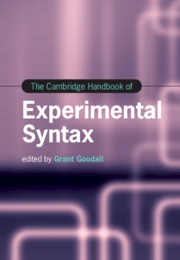Book contents
- The Cambridge Handbook of Experimental Syntax
- The Cambridge Handbook of Experimental Syntax
- Copyright page
- Contents
- Figures
- Tables
- Contributors
- Introduction
- Part I General Issues in Acceptability Experiments
- Part II Experimental Studies of Specific Phenomena
- Part III Experimental Studies of Specific Populations and Language Families
- Part IV Experimental Syntax beyond Acceptability
- 22 Theories All the Way Down
- 23 Eye-Tracking and Self-Paced Reading
- 24 Nothing Entirely New under the Sun: ERP Responses to Manipulations of Syntax
- 25 Corpus Studies of Syntax
- 26 Syntax and Speaking
- 27 Neuroimaging
- Index
- References
24 - Nothing Entirely New under the Sun: ERP Responses to Manipulations of Syntax
from Part IV - Experimental Syntax beyond Acceptability
Published online by Cambridge University Press: 16 December 2021
- The Cambridge Handbook of Experimental Syntax
- The Cambridge Handbook of Experimental Syntax
- Copyright page
- Contents
- Figures
- Tables
- Contributors
- Introduction
- Part I General Issues in Acceptability Experiments
- Part II Experimental Studies of Specific Phenomena
- Part III Experimental Studies of Specific Populations and Language Families
- Part IV Experimental Syntax beyond Acceptability
- 22 Theories All the Way Down
- 23 Eye-Tracking and Self-Paced Reading
- 24 Nothing Entirely New under the Sun: ERP Responses to Manipulations of Syntax
- 25 Corpus Studies of Syntax
- 26 Syntax and Speaking
- 27 Neuroimaging
- Index
- References
Summary
Purportedly (morpho)syntactic-event-related brain wave components – P600, LAN, and e[arly]LAN – have over the years proved more likely to be domain-general responses. Studies comparing late positive responses to anomalies across cognitive domains, and manipulating their probability of occurrence, suggest that the P600 is a member of the P300 family. Other studies report individual variation in response to (morpho)syntactic anomalies, smudging the distinction between N400 and P600 responses, and suggesting that LAN responses to morphosyntactic anomaly may be an artifact of N400+P600 overlap. The eLAN has similarly been shown to be a methodological artifact. We argue that studies of long-distance dependencies have produced the most consistent and reliable results, partly because they largely avoid violation paradigms, although current insights may be profitably applied to ERP studies of syntactic islands. We also suggest that what are taken to be specialized effects of referential processing are in fact another manifestation of such long-distance (anaphoric) effects.
Keywords
- Type
- Chapter
- Information
- The Cambridge Handbook of Experimental Syntax , pp. 641 - 686Publisher: Cambridge University PressPrint publication year: 2021
References
- 1
- Cited by



